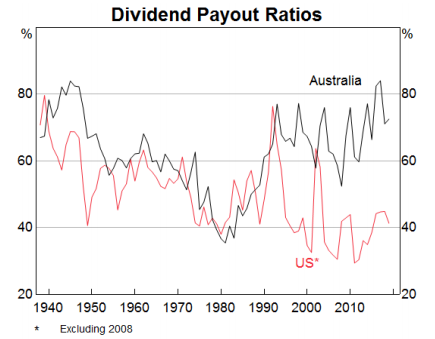On 21 December 2018, the S&P/ASX 200 Index closed at 5467.64, close to a year later on 7 November 2019, the S&P/ASX 200 Index closed at 6,726.6, equating to a rally of 1,258.96 points or +23.03 per cent over the period.
Meanwhile, in the one-year to 6 November 2019, the index has gained +13.36 per cent or 784.98 points. This was because On 6 November 2018, the index closed at 5,875.18, which is 407.54 points higher compared to the close on 21 December 2018.
Moreover, the market presents investors with numerous opportunities to maximise their returns, mostly in times when the markets are heading south. In between the past one year, the index also touched its all-time high in July 2019.
Shareholder Return
A country with just below $3 trillion dollars in superannuation assets needs relatively better shareholder returns. According to the Association of Superannuation Funds of Australia (ASFA), the superannuation assets in Australia were $2.9 trillion at the end of June 2019 quarter.
Australians contributed $33.9 billion in the June quarter, depicting an increase of 3.6 per cent over the June quarter in 2018. In addition, the annual industry-wide rate of return for an account having more than four members was 7.3 per cent for the year ending June 2019.
Although, it is a well-known fact that retirement pension plans generally invest in fixed income investments or relatively safer investments with fewer risks. However, considering the present low interest rate environment, it would be difficult to fetch an annual return of 7.3 per cent through investing in fixed income assets.
According to RBA, the Australian share prices have increased by a geometric average of around 6 per cent a year over the past 100 years; including the impact of inflation, the return comes to 2 per cent.

Source: RBA
Further, it is said that the dividends payments in Australia equities are relatively higher than the other countries due to their tax treatment. Prior to the introduction of franking credits in 1987, the dividend pay-outs used to track the dividend pay-outs in US equities closely.
Resilient Business Models
A business model is a prime catalyst in creating value to customers, partners, and the company. It is simply the answer to the basic economic question to businesses; what to produce, for whom, and how to make profits out of it.
Firms must continually innovate their business models and failing to do so could pose many risks to the business, most prominently, the increasing competition with better and innovative products and offerings. Historically, there have many examples in this regard, including Apple in mobile phones and MP3 players, wikipedia and encyclopaedias etc.
Business model innovation allows the businesses to revamp their existing business that is not able to complement effectively to the existing trading conditions. Customers remain the king, and broadly, the crux of any business model revolves around customers.
Businesses need to have an effective insight about their customers, including the behaviour of targets users, the context of the product or service. Relatively better knowledge about the customers only provide businesses with better resources to make decisions on new and innovative business models.
Letâs go through some real-world examples:
- The demerger of Cardno Limited (ASX: CDD) to form Intega Group Limited is an example of a change in the business models.
- The demerger of Coles Group Limited (ASX: COL) from Wesfarmers Limited (ASX: WES) is also an example of effective and efficient decision making.
- The upcoming demerger of Endeavour Group from Woolworths Limited (ASX:WOW) is seeking to create a new entity.
- Companies adapting to economic headwinds through cost cuts and efficiency gains.
Largely, the Australian businesses are pro-active in adapting to new business models amidst wider disruptions in the market, such as Wesfarmers adapting to free-delivery formats, strategic partnerships with similar business etc.
Interest Rate
Over the past one year, the interest rates in the country have come down by 50%. At this time around in 2018, the RBA cash rate was standing was 1.5 per cent, and presently, the RBA cash rate stands at 0.75 per cent. Although, the current cash rate stands at the historically lowest level, it stood at 7.25% in August 2008.

RBA Cash Rate (Source: RBA)
The Reserve Bank of Australia has been slashing cash rate this year in a bid to revive the sluggish economic growth in the country. Consequently, the shift in the interest rates is possibly giving tough to time income-savvy investors.
As a result of lower interest rate, the yields on the broader bond market tend to hit the lower extremes levels as well, forcing an investor to shift assets to such classes that have at least some positive real returns.
Some Australian companies allow investors to have positive real returns in dividends, which is also an encouraging sign for income-savvy investors. Low interest environment allows companies to cut down on interest payments on floating -rate debts and provides scope for refinancing the debt to have a comparatively lower-interest outgo.
Disclaimer
This website is a service of Kalkine Media Pty. Ltd. A.C.N. 629 651 672. The website has been prepared for informational purposes only and is not intended to be used as a complete source of information on any particular company. Kalkine Media does not in any way endorse or recommend individuals, products or services that may be discussed on this site. Our publications are NOT a solicitation or recommendation to buy, sell or hold. We are neither licensed nor qualified to provide investment advice.



